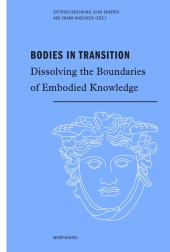 Neuerscheinungen 2015Stand: 2020-02-01 |
Schnellsuche
ISBN/Stichwort/Autor
|
Herderstraße 10
10625 Berlin
Tel.: 030 315 714 16
Fax 030 315 714 14
info@buchspektrum.de |

Dietrich Boschung, Alan Shapiro, Frank Waschek
(Beteiligte)
Bodies in Transition
Dissolving the Boundaries of Embodied Knowledge
Ed.: Boschung, Dietrich; Shapiro, Alan; Waschek, Frank
1st Ed. 2015. 372 p. w. 80 b&w, 22 col. ill. 233 mm
Verlag/Jahr: FINK (WILHELM) 2015
ISBN: 3-7705-5808-1 (3770558081)
Neue ISBN: 978-3-7705-5808-7 (9783770558087)
Preis und Lieferzeit: Bitte klicken
This volume deals with the dissolution of the concept of the ideal body as a repository of knowledge through instances of deformation or hybridization
The starting point comprises a series of case studies of less than perfect bodies: bodies that are misshapen, stigmatized, fragmented, as well as hybrid human/animal creatures, transgendered persons, and bodies on the cultural periphery of the classical world. These examples represent deviations from the "normal" order of things and evoke feelings of alienation. One strategy for dealing with this is to canonize transgression in visual form. Fluid bodies are captured in the image, creating a visual order in disorder. The body-as-ruin is a fixed figure of fluidity and thus receptive to attributions of meaning, which helps explain its persistence as a cultural trope. It allows for the observation of cultural change.
This volume engages from the perspective of the ancient Mediterranean world with current debates in the field of cultural studies revolving around the idea of embodied knowledge. In particular, it deals with the dissolution of the concept of the ideal body as a repository of knowledge through instances of deformation or hybridization.
The starting point comprises a series of case studies of less than perfect bodies: bodies that are misshapen, stigmatized, fragmented, as well as hybrid human/animal creatures, transgendered persons, and bodies on the cultural periphery of the classical world. All of these examples represent deviations from the ´normal´ order of things and evoke familiar feelings of alienation. The ordered knowledge that has shaped the body is subverted and falls into disorder.
One strategy for dealing with this is to canonize transgression in visual form. Fluid bodies are captured in the image and domesticated, creating a visual order in disorder. The body-as-ruin is a fixed figure of fluidity and thus especially receptive to attributions of meaning, which helps explain its persistence as a cultural trope. It allows for the observation of cultural change.


